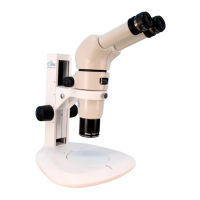Notes on Handling the Product
xii
Notes on Handling the Product
1 Handle the product carefully.
This product is a precision instrument. Avoid
subjecting it to sudden impacts and shocks.
Even relatively minor impacts are capable of affecting
the precision of the objective.
2 Electromagnetic Environment
Before using this product, Nikon recommends
evaluating the electromagnetic environment of the
installation site.
Do not use this product close to strong
electromagnetic radiation sources (example:
unshielded intentional RF sources). They may
interfere with the proper operation of this product.
This product emits low-level electromagnetic
radiation. Do not install this product near precision
electronic devices. Otherwise, the performance of
such devices might be degraded. If TV or radio
reception is affected, move the TV or radio farther
away from this product.
3 Scratches, dirt, and foreign particles on the lens
Scratches or fingerprints on optical components
(such as lens and filters), etc. will degrade
microscope images.
If these parts become dirty, clean them as described
in Chapter 7, “1.1 Cleaning Lenses.”
4 Installation location
This product is a precision optical instrument. Usage
or storage of this product in an inappropriate
environment may result in malfunction or a
degradation in precision. Consider the following
factors when selecting an installation location:
● Select a location free of vibration. Install this
product on a level surface.
● Install this product at least 10 cm away from walls.
● Select a location less exposed to hazards in the
event of collisions, earthquakes, or other potential
disasters. To keep this product from falling, use a
strong rope or other means if necessary to secure
it to the working desk or other heavy, stable item.
● Select a layout that allows easy removal of the
power cord from the device’s AC inlet in the event
of an emergency.
● Do not use a desk mat or similar.
● Avoid locations exposed to direct sunlight,
locations immediately under room lights, and other
bright locations.
● Light from room lights directly above this product
may enter the objective as extraneous light. If
possible, switch off the room lights directly above
this product when observing samples.
● Select a location with minimal dust.
● To avoid splashes, do not use this product near
water.
● Make sure the ambient temperature is 0 to + 40C
and humidity is 60% RH max. at 40C (with no
condensation). When transporting or storing this
product, the ambient temperature must be -20 to
+60C, with the humidity at 90% RH max (with no
condensation). If the product is installed in a
location with high temperature and high humidity,
mold and/or condensation may be generated on
the lenses. Furthermore, performance
deterioration and malfunction may occur.
● Do not place this product in a locker or cabinet.
5 Handling a focus knob
Never turn the focus knobs in opposite directions at
the same time. Doing so may damage the product
depending on the model. For details on how to use
the knobs correctly, see Chapter 4, “Functions and
Operations of the Devices.”
6 Protect the ports from dust and extraneous light
If not using the vertical tube part of the tube, be sure
to attach the supplied cap. Otherwise, extraneous
light and dust may be trapped inside the product.
7 Handling of filters (when using the
epi-fluorescence attachment)
● Excitation filters inside a filter cube are exposed to
strong light and degrade over time. Replace them
after the appropriate number of hours of use.
● Filter characteristics may alter if the filter is
exposed to high humidity. To prevent changes or
degradation of filter characteristics, avoid using or
storing the filters under conditions of high humidity
or high temperature. Avoid subjecting filters to
rapid temperature changes. When a filter is not in
use, store in a desiccator or hermetically sealed
container with a drying agent.
● Especially the filters in GFP type filter cubes offer
sharp, high-resolution waveform characteristics
superior to normal filters. However, due to their
sophisticated coatings, they must be handled with
special care. Be sure to handle the filters carefully.
Take care to avoid abrasion from cleaning. Follow
the description in Chapter 7, “1.1 Cleaning
Lenses.”

